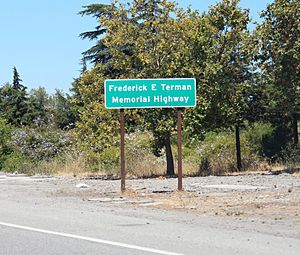Frederick Terman facts for kids
Quick facts for kids
Frederick Terman
|
|
|---|---|
 |
|
| Born |
Frederick Emmons Terman
June 7, 1900 English, Indiana, U.S.
|
| Died | December 19, 1982 (aged 82) Palo Alto, California, U.S.
|
| Nationality | American |
| Alma mater | Stanford University Massachusetts Institute of Technology |
| Awards | IEEE Medal of Honor (1950) IEEE James H. Mulligan, Jr. Education Medal (1956) IEEE Founders Medal (1963) National Medal of Science (1975) |
| Scientific career | |
| Fields | Electrical engineering |
| Institutions | Stanford University Massachusetts Institute of Technology |
| Doctoral advisor | Vannevar Bush |
| Notable students | Bill Hewlett Bernard M. Oliver David Packard Wen-Yuan Pan Russell and Sigurd Varian Oswald Garrison Villard Jr. Paul W. Klipsch |
Frederick Emmons Terman (born June 7, 1900 – died December 19, 1982) was an American professor and university leader. He was a dean and provost at Stanford University. He is often called the "father of Silicon Valley" because of his big role in its growth.
Contents
Early Life and Hobbies
Frederick Terman was born on June 7, 1900, in Indiana, U.S. His father, Lewis Terman, was a famous psychologist. He studied smart children and helped make the IQ test popular in America.
When Frederick was 10, his family moved to Stanford, California. His father became a professor at Stanford University. As a boy, Frederick loved his ham radio hobby.
Frederick Terman's Education
Frederick Terman studied at Stanford University. He earned his first degree in chemistry. Then, he got his master's degree in electrical engineering.
He later went to the Massachusetts Institute of Technology (MIT). In 1924, he earned a Doctor of Science (ScD) degree. His advisor there was Vannevar Bush, who later helped create the National Science Foundation.
A Career in Engineering
Terman came back to Stanford University in 1925. He joined the engineering teaching staff. From 1925 to 1941, he created new courses and research in electronics. This work focused on things like vacuum tubes, circuits, and instrumentation.
He also wrote an important book called Radio Engineering. This book became a key guide for electrical and radio engineers. Many of his students at Stanford became very successful. These included William Hewlett and David Packard, who later started Hewlett-Packard. Terman encouraged his students to create their own companies. He even invested his own money in some of them. This led to famous companies like Litton Industries, Varian Associates, and Hewlett-Packard.
World War II Efforts
During World War II, Terman led a large team at Harvard University. His team worked on secret projects to help the Allied forces. They developed ways to block enemy radar signals. They also created special strips of aluminum, called "chaff," to confuse enemy radar. These inventions made enemy anti-aircraft guns less effective.
Building Silicon Valley
After the war, Terman returned to Stanford. He became the dean of the School of Engineering. In 1951, he had a great idea. He helped create the Stanford Industrial Park, now called Stanford Research Park. The university leased its land to high-tech companies.
Companies like Varian Associates, Hewlett-Packard, and Lockheed Corporation moved there. This area became a center for new ideas and technology. It eventually became known as Silicon Valley.
Terman also served as the Provost at Stanford from 1955 to 1965. A provost is a senior university leader. He greatly expanded the science and engineering departments. He helped Stanford get more research money from the Department of Defense. This funding helped Stanford become a world-class university. It also helped Silicon Valley grow even more. Terman's work created a strong link between Stanford and the tech companies nearby.
In 1964, Terman became a founding member of the National Academy of Engineering. He also helped establish the Korea Advanced Institute of Science (KAIST) in South Korea. A building at KAIST, Terman Hall, is named in his honor.
Recognition and Legacy
Frederick Terman received many awards for his work.
- In 1950, he earned the IEEE Medal of Honor. This was for his contributions as a teacher, author, scientist, and leader.
- He was also a member of important groups like the National Academy of Sciences.
- The Frederick Emmons Terman Award is given each year to a great young electrical engineering teacher.
- The Frederick Emmons Terman Engineering Scholastic Award goes to top students at Stanford's School of Engineering.
- A section of U.S. Route 101 in California near Palo Alto is named the Frederick E. Terman Memorial Highway.


